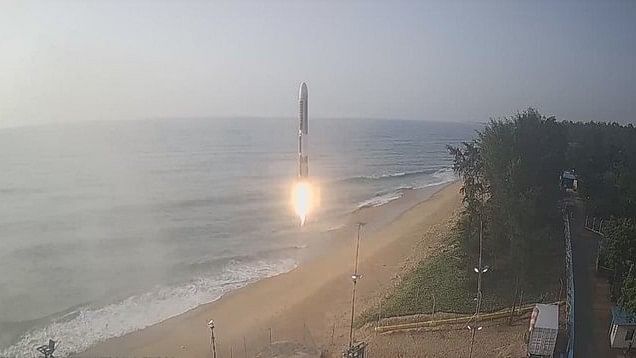
The launch of Agnibaan SOrTeD (Suborbital Technological Demonstrator) by space tech start-up Agnikul Cosmos.
Credit: X/@AgnikulCosmos
Chennai-based Agnikul Cosmos’ successful launch of its rocket Agnibaan on Thursday marked a milestone for the seven-year-old start-up as well as for India’s ‘New Space’ companies, most of them start-ups. To be sure, Agnikul’s was not the first privately-made rocket to be launched in India; that honour belongs to Hyderabad-based Skyroot Aerospace, which launched its Vikram S rocket into sub-orbital flight in November 2022. And like Skyroot’s launch, Agnikul’s rocket also made a sub-orbital flight, reaching an altitude of a little over 8 km. Indeed, the rocket was called Agnibaan SOrTeD (Sub-Orbital Technology Demonstrator). But Agnikul can boast of at least three firsts with its launch – it was powered by the world’s first 3D-printed rocket engine; it was India’s first semi-cryogenic rocket engine, flying on a kerosene-liquid oxygen (LOX) fuel-oxidiser mixture; and it was launched from India’s first private space launch pad, Agnikul’s own ‘Dhanush’ pad, and monitored from the company’s own mission control centre, albeit located within ISRO’s space launch complex at Sriharikota.
All these technology and business choices are highlights of the Agnibaan launch. Using 3D-printing, or Additive Manufacturing, to make rocket engines speeds up the process of building rockets and lowers the cost of space launches. While making rocket engines the conventional way takes 3-4 months, Agnikul CEO Srinath Ravichandran says 3D-printing one takes just three days. That means, Agnikul can offer customers on-demand launch capability. The fuel is kerosene (Aviation Turbine Fuel), widely available and easy to handle. And Dhanush is a mobile launch pad, which allows flexibility in terms of launch location. The technologies have been demonstrated. Agnikul will now look to make an orbital flight before the end of the financial year and then undertake commercial launches for paying customers next year. The Agnibaan rockets will be two-stage rockets that will be able to launch satellites weighing up to 100 kilos into 700-km high low-earth orbit.
The Agnibaan launch also signifies the success of the Narendra Modi government’s space policy and validates the strategy it adopted, through the formation of the Indian National Space Promotion and Authorisation Centre (In-SPACe), to encourage the rise of a private space industry in India to compete with those in the US and China and those rising in Europe and Japan. That Agnikul was incubated by IIT-Madras and has been strongly supported by ISRO is commendable. The government’s space policy allows ISRO to share its expertise, experience, technologies and facilities with the private industry through agreements, and ISRO has done well to do so with Agnikul, Skyroot and several other space start-ups. ISRO, too, stands to benefit from the innovation and risk-taking ability of these start-ups. It is a model that other government science and technology institutions could adopt.